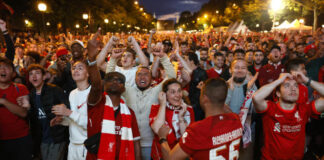The date is unusual, the decor is unique. At the start of July, the courts and bleachers of the Roland-Garros stadium come alive, more than a month after Rafael Nadal’s fourteenth coronation. In the shadows, the grounds of the Porte d’Auteuil have been transformed and will soon hear the resonance of a small felt ball again, but not the one we believe, highlighting that of padel.
On the immutable clay courts nº 2 to nº 6, synthetic tracks of 20 meters by 10 meters have been built, crossed by a net, surrounded by large windows and grids. Even the Philippe-Chatrier floor is no exception, also repainted in the colors of padel. Roland-Garros hosts from July 11 to 17 the Paris Premier Padel Major, considered a “Grand Slam” – the highest category of tournament on the circuit -, and thus hopes to give a big spotlight to this spectacular discipline.
Born in 1969 in Acapulco (Mexico), this hybrid racket sport is inspired as much by squash as by tennis and has the particularity of being practiced only in doubles. Quickly adopted in Central and South America, padel landed in Europe at the same time: the first courts were born in Marbella, on the Costa del Sol (Spain), where the discipline was rapidly gaining in popularity. Love at first sight is such that the country now has more than four million players, more aficionados than its big brother, tennis.
“A real turning point”?
In France, padel interfered in the sphere of racket sports in the early 2010s, supported by tennis players tired of the traditional yellow ball and by sportsmen and celebrities of all kinds, from Zinédine Zidane to Cyril Hanouna. In 2014, the French Tennis Federation (FFT) absorbed that of padel, a decisive step in its development. Since 2020, the discipline has been the one with the strongest increase in its number of practitioners, according to figures from the Ministry of Sports and the FFT. With 300,000 paddlers counted in France, the amateur branch is gradually taking root there, while the professional one is still struggling to stand out.
Alejandro Galan, Juan Lebron or even Fernando Belasteguin: as many deified padel players in the Hispanic world as unknown names on French soil. At the Paris Major – which will feature 56 teams – these headliners will be tracked down by an insider audience. A starification process, the slowness of which is felt by the tricolor flagship. “We would benefit from highlighting the best French players, supports Benjamin Tison, 69th world padel player, and number one in France. It would help the professional padel in France and it would allow the youngest to be able to identify themselves. »
Exiled to Barcelona since 2018 to train with the elite, the native of Mantes-la-Jolie (Yvelines) approaches Roland-Garros with ambitions, certainly personal, but above all national: “If I had been told there a year ago that we would play on the [court] Chatrier, I would have had a hard time believing it, concedes the 33-year-old padel player. But when I see the current explosion of padel in France and Europe, I think it goes beyond just a fashionable sport: this tournament can be a real turning point. “Remains to be determined for whom.
Nasser Al-Khelaïfi shakes up the circuits
In constant evolution, the world of padel and its professional circuits can confuse the less informed. With two distinct competitions already in place, the World Padel Tour (WPT) and the American Padel Tour (APT), the grid has blurred even further this year with the arrival of a third juggernaut: the Premier Paddle Tour. Supported by the Association of Professional Padel Players and financed directly by Qatar Sports Investments (QSI), a subsidiary headed by the president of Paris-Saint-Germain, Nasser Al-Khelaïfi, Premier Padel has come to reshuffle the cards.
First, it offers higher rewards during tournaments: for example, the overall prize pool of the Paris Premier Padel Major will be 525,000 euros, almost five times more than a major World Padel Tour tournament, and about four times more than the major event of the APT Padel Tour. Added to this are less restrictive contracts and increased media exposure.
“Nasser wanted to move the lines, sums up the Frenchman Arnaud Di Pasquale, former 39th in the world in tennis and in charge, since 2021, of the padel mission at the FFT. He said to himself that it was not possible to leave the padel in this place. “With such a seduction operation, it is difficult for padel players not to be conquered, on the slopes as much as in the stands, leaving only the World Padel Tour disappointed, whose contracts with its players will end in 2023.
The only black spot so far, and not the least: the absence of players from tournaments organized by Premier Padel. “Seeing the boys play, and not the girls, makes me want to cry,” fumes Alix Collombon, 23rd player in the world and number one in France. Premier Padel and Nasser, however, want a female table. Simply, the women have not yet signed with this new circuit, while the boys have made the decision to go against their initial contract with the WPT. “A situation that should be resolved for the next edition.
Olympic and emancipation desires
From QSI to the FFT, important exogenous players have smelled the right vein and are structuring the padel. “The Ministry of Sports proposed in 2014 to the FFT to recover the delegation, which it accepted, traces Arnaud Di Pasquale. The impetus is given by tennis but, today, there is no cannibalization. “An ambivalent status, decried by certain actors in the field, including the leader of a huge padel center in Ile-de-France: “I think that the little brother of tennis will no longer be so for very long, advance- he on condition of anonymity. The FFT has helped us, but it could restrict us in the future. We know our sport and its potential, we will have to regain control. »
Positions tempered by French figureheads, aware of the work done by the Federation: “Padel is financed and developed by the FFT and, in return, wins licenses for tennis which loses [individually]: it is a win-win relationship,” defends Benjamin Tison. “The problem was having tennis teachers who don’t know how to teach padel. We were listened to and, in September, a national diploma will be launched to improve this: the Federation is so powerful, has a lot of money, that can only help, ”underlines Alix Collombon.
For everyone, Roland-Garros is a crucial stage, an obligatory passage in the setting of tennis, paradoxically as if to emancipate oneself from it. But the real ambitions are international and, more specifically, Olympic: “For 2028 [at the Los Angeles Games], that seems right to me, laments Benjamin Tison. But I think with such an explosion, in so many countries [there are 25 million practitioners in the world], the sport will soon be Olympic, who knows, maybe in 2032? In the land of sliding at the Games in Brisbane (Australia), padel would continue to surf on its notoriety and could, finally, stand out from stand-up paddle, its misleading homophone.














